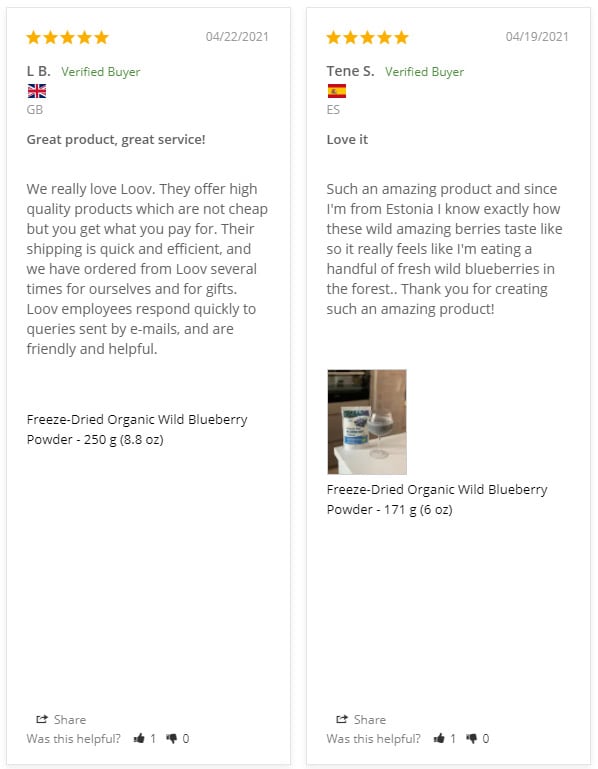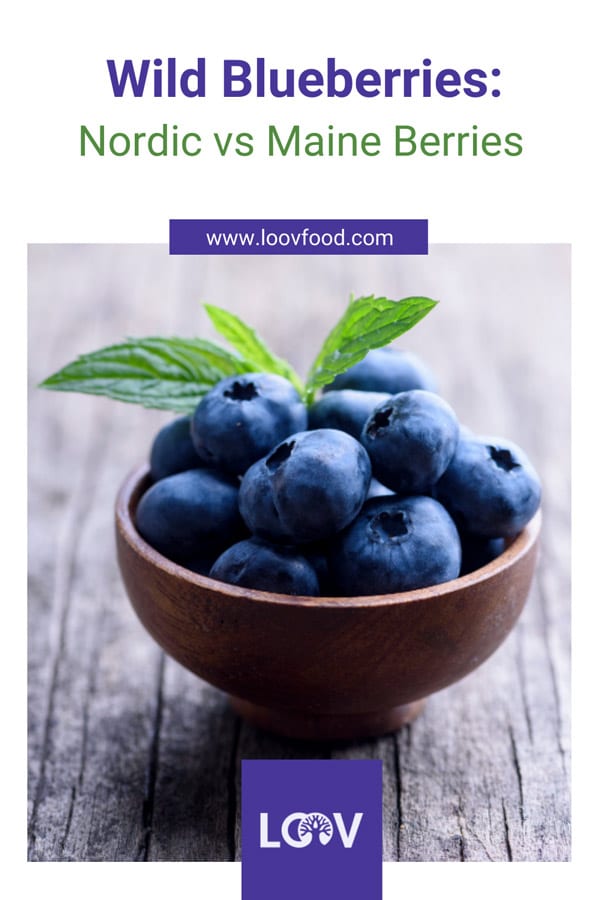Picking wild blueberries that best meet your needs can be a daunting task.
In fact, if you’re not familiar with these fruits, it’s hard to tell them apart. But don’t beat yourself up.
Table of Contents
1. Naturally Nordic Wild Blueberries
2. Maine Wild Blueberries
3. Health Benefits of Nordic vs. Maine Blueberries
4. Wild Doesn’t Always Mean Naturally ‘Wild’
5. Contamination With Synthetic Chemicals
5.1. The Nordic Wild Blueberry: Source
5.2. Maine Wild Blueberries: Source
6. Ease of Storage
7. How Can You Tell the Difference?
8. Wondering Where to Buy Healthy Organic Wild Blueberries?
Even blueberry fans are pretty split between the most nutritious, pocket-friendly, and easy-to-store wild blueberries.
Whether you’re just learning about wild blueberries now, or you’re a regular consumer of these fruits, this article will help you make an informed choice.
To get started, we’ll compare the naturally nordic blueberry (the bilberry) and Maine’s wild blueberry in the following four categories:
- Health benefits
- How they’re grown
- Contamination by synthetic chemicals
- Ease of storage
Then, based on what we’ve revealed, we’ll crown the best wild blueberry for you and your family.
Naturally Nordic Wild Blueberries
These blueberries are also called bilberries, dwarf bilberries, and whortleberries, but their scientific name is Vaccinium myrtillus.
They’re bluish-black with brownish-red seeds and hang singly at the lowermost leaves of their lowbush shrubs.
The wild fruits are mostly native to northern Europe, particularly the Nordic forests found in Finland, Estonia, and Sweden. Hence, the name Nordic wild blueberries.
Maine Wild Blueberries
Scientists call these blueberries Vaccinium angustifolium. The fruits are bluish-purple and have white bell-shaped flowers.
The plant is famous for being fire-tolerant and can hibernate for 100 years.
The wild blueberries are indigenous to Northeastern America. Although they grow wildly in the barrens and mountains, they are also widely produced in New England and Quebec in Canada for commercial purposes.
Now that introductions are out of the way, let’s see how they compare in the four categories mentioned above.
Health Benefits of Nordic vs. Maine Blueberries
We know that wild blueberries are the giants of nutrition. But which of the two blueberries is more nutritious?
| Nutrients per cup |
Nordic wild blueberry (bilberry) |
Maine blueberry | Health benefits |
| Anthocyanins and antioxidants | 800 mg | 400 mg | Improves vision by repairing retinal cells, repairs DNA, prevents degenerative diseases, decelerates ageing, reduces risks of malignancy |
| Carbohydrates | 21 grams | 18 grams | Removes bad breath, regulates blood cholesterol, reduces fatigue, improves concentration, helps digest fat |
| Sugar | 10 grams | 15 grams | Improves sleep, aids in digestion, energy booster, |
| Fiber | 3.6 grams | 3 grams | Improves bowel movement, helps achieve healthy weight, prevents blood sugar irregularities. |
| Protein | 0.7 grams | 0.04 grams | Strengthens bones, improves muscles, boosts immunity |
Maine’s wild blueberry only beats the Nordic wild blueberry in the sugar content subcategory, meaning that it’s more effective as a natural food sweetener.
However, it’s lower in other essential nutrients, making the Nordic blueberry the winner of the health benefits category.
Wild Doesn’t Always Mean Naturally ‘Wild’

Our Nordic Wild Blueberries are grown naturally deep in the forests. The crops are far away from industry, roads, and possible pollutants. When they’re ready to be harvested they’re hand-picked.
Left to fend for themselves, they are at the mercy of mother nature. Most of the time she’s kind and they grow abundantly and healthily. At other times, there can be weather elements that can result in a less than satisfactory yield. That’s ok, we still deliver to you only the most natural berries.
American Wild Blueberries are also grown in the wild, however, they aren’t left to their own devices. There’s a load of human involvement, including the possible use of fertilizers containing pesticides. Their goal is to produce bountiful harvests no matter what the elements do.
The question we want to answer in this category is, which wild blueberry will fill your basket for less?
Our Nordic blueberries are competitively priced, we may have had an excellent year and huge yields, bringing the prices down. If we have a more challenging time, prices may be higher.
Blueberry prices are considerably influenced by:
- Storage costs
- Shipping costs
- Packaging costs
- Customs duty/import tax
- Production costs
American wild blueberries may appear to be lower in price if they’ve had a successful yield, but at what cost to the product?
Always choose quality over low-priced quantity. This is what our customers have to say about our wild blueberries:
Contamination With Synthetic Chemicals
You want a blueberry that’s as organic as possible.
To be able to tell how pure each contestant is, we need to explore each one’s indigenous habitat.
Since they belong to the same family and genus, the wild blueberries thrive under similar climates and soil pH. That is:
The Nordic Wild Blueberry: Source
Unlike the highbush and Maine blueberry varieties, nobody plants Nordic wild blueberries—they’ve grown on their own in the Nordic forests for 10 millenia. This is what makes these blueberries wild.
To survive in a harsh, cold environment, Nordic wild blueberries contain large amounts of phytochemicals called anthocyanins. This explains the high concentration of antioxidants, hence the intense blue color.
The bluer your tongue the more antioxidants in the berries
The high polyphenol concentration increases the blueberries’ antioxidant capacity, giving them a nutritional advantage over Maine’s wild blueberries.
Nordic wild blueberries ripen sometime in September, although the season can begin anywhere between June and July depending on the region.
Unlike their American cousins, these lowbush Nordic berries are quite difficult to harvest. They are hand-picked or harvested with other forest berries using rakes and then sorted later.
Maine Wild Blueberries: Source
Maine wild blueberries are planted by sowing seeds or using rhizomes.
Although these blueberries aren’t as labor-intensive as their highbush cousins, growers can’t be completely hands-off with this crop.
The plants are lowbush and prefer full sunlight. Therefore, weeding is done to eliminate partial shade cast by taller plants.
Weeding also removes growing vegetation that competes for plant food and water.
To aid in pollination, growers introduce worker bees to the fields. These bees are carefully selected from colonies that are disease and pest-free. This is because some bees carry fungal diseases like chalkbrood to the fields.
To improve yields, growers prune the bushes by burning. Maine’s wild blueberries are known to sprout back stronger with healthy buds and new growth after this. Where burning is not applicable, field owners mow.
Fertilizers and pesticides are also used to increase production and protect the fields from common pests.
When grown in North America, Maine wild blueberries are harvested between July and early September. However, the harvesting seasons may vary depending on the regions where the fruits are.
Ease of Storage
Both types of wild blueberries can last for years when preserved correctly.
The most effective food preservation technique is called freeze-drying.
This method retains 97% of the blueberries’ nutrients. Thus, freeze-dried blueberries may be better than the frozen berries in your local grocery store.
When we pick our blueberries, we extract the water from them, creating a dry product (known as freeze-dried). The best way to store these is in an air-tight container at room temperature, free from any moisture.
Freeze-dried wild blueberries don’t need to be frozen. In fact, this can put them at risk of absorbing moisture, and end up lumpy.
Be careful when buying frozen blueberries. They rely on the environment to be completely cold at all times. If this freezing chain is broken in any way, for example, if you leave them sitting in a hot car, the value of the berry deteriorates.
Our blueberries are delivered to you in air-tight packaging, ready for eating and with all of their goodness intact.
How Can You Tell the Difference?
From the comparisons above, it’s clear that the Nordic wild blueberry is superior in every way. Both its quality of nutrition and its natural sourcing set it apart as the best wild blueberry.
But how do you know which berry is which?
| Nordic wild blueberries | Maine wild blueberries |
| Smaller wild fruits of average size 0.8 cm or 0.31 inch diameter | Bigger fruit size of about 1.2 cm or 0.47 inch diameter |
| Have strong tart flavor when put in food or dessert | Have softer texture and less flavor when used in food or dessert |
| Berries stain with intense blue color when eaten | Berries will stain less |
| Have strong fragrant flesh | Have mild fragrant flesh |
| Not commonly found in grocery stores in the US or Canada, but you can shop for organic wild blueberries online | Sold frozen in most grocery stores in North America but can also be ordered online |
Wondering Where to Buy Healthy Organic Wild Blueberries?
With the growing demand for wild blueberries, field owners want to increase production.
This has proven quite hard to achieve without compromising the authenticity of the crop by using pesticides, fungicides, fertilizers, hormones, and other chemicals.
How do you make sure that you’ve picked the right organic wild blueberries?
Always check the package to see where the blueberries come from. They’re all labeled as “wild blueberries”, however, Nordic bilberries come from northern European countries such as Finland, Sweden, and Estonia.
Don’t stop at that; check the blueberries’ ingredient section to ensure that your blueberries have no preservatives and no added sugar.
Genuine dealers in wild blueberries should indicate this information to make it easy for you to decide.
At LOOV, our products are authentic and unadulterated.
Enjoy amazing offers and prices by visiting LOOV today.
Share on Pinterest:








